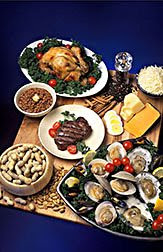Exercise, Fitness & Dietary Nutrition – Zinc
Posted by: Kevin Flatt Healthy Exercise, Fitness & Dietary Nutrition: Consuming lower than recommended levels of dietary zinc could be especially hard on the body during exercise, according to an Agricultural Research Service (ARS) study.
Healthy Exercise, Fitness & Dietary Nutrition: Consuming lower than recommended levels of dietary zinc could be especially hard on the body during exercise, according to an Agricultural Research Service (ARS) study.
Ever wonder how some people exercise routinely with a bounce in their step, while others get to the gym and soon end up staggering to the first chair they see?
An answer may lie in the interrelationship between a common enzyme and tiny amounts of the mineral zinc it contains. Hundreds of zinc-dependent enzymes are thought to be involved in key metabolic responses that regulate energy expenditure.
Lower-than-recommended levels of zinc could therefore take a toll on the body, particularly during exercise.
One such zinc-dependent enzyme, carbonic anhydrase, helps the body clear away byproducts of daily cellular activity. The enzyme transfers carbon dioxide from body tissues to blood, and then from blood to air sacs in the lungs so it can be released.
A study published in 2005 by ARS physiologist Henry C. Lukaski shows that low dietary zinc impairs red blood cell carbonic anhydrase activity, which strains the metabolic response during exercise.
Lukaski is assistant director of ARS’s Grand Forks Human Nutrition Research Center, in Grand Forks, North Dakota.
“The heart and brain have chemical sensors that can tell when carbon dioxide is building up in the system,” says Lukaski. “Those sensors stimulate the body to try to work harder. The result is that the person may start panting as the heart struggles to pump blood to the lungs to expel byproducts.”
Study participants—active young men in their 20s and 30s—experienced a significant drop in physiological efficiency while exercising after their zinc intake had been reduced for 9 weeks.
They ingested 3.5 milligrams (mg) daily, about one-third of the Recommended Dietary Allowance of 11 mg daily.
For contrast, after a 6-week break, the same group exercised the same way for 9 more weeks while being supplemented with 15 mg of zinc daily. During that time, their physiological response was normal while they exercised.
The study showed how low zinc intake affects carbonic anhydrase activity in red blood cells and in heart function during exercise.
“During periods of low zinc intake, carbon dioxide backs up all the way to the muscle cell,” says Lukaski. “That results in acid-laden cells, which require more oxygen for clearing toxic byproducts.”
A personalized nutrient intake assessment, which includes a zinc-intake audit, is available free from USDA. Log on to http://www.mypyramidtracker.gov/, and key in the foods you’ve eaten in a day—preferably 2 days or more—up to a year’s worth. This will generate the amount of your daily zinc intake from foods and compare that with the recommended zinc intake based on your sex and age. Good sources of zinc include oysters, fortified breakfast cereals, lean beef, and beans.
Source: Rosalie Marion Bliss, Agricultural Research Service Information Staff, USDA, ARS. Photo courtesy USDA, ARS. Used with permission.
Related articles:
Creatine Side Effects: Myths and Safety Profile – Part 1 of 5
Facts and Benefits of Creatine – Part 2 of 5
The Best Creatine? Creatine Monohydrate Effectiveness – Part 3 of 5
Medical Safety of Creatine Supplementation – Part 4 of 5
Should Creatine Supplements be Banned? – Part 5 of 5
Exercise Tips and Myths
Stretching Before or After Exercise? Misconceptions Explained
Strong Abdominal Muscles Don’t Require Exercise Machines
Linking Cognitive Functioning and Exercise
Physical Activity or Exercise? – Making a New Year’s Resolution
Is Starting a New Exercise Program Your New Years Resolution?